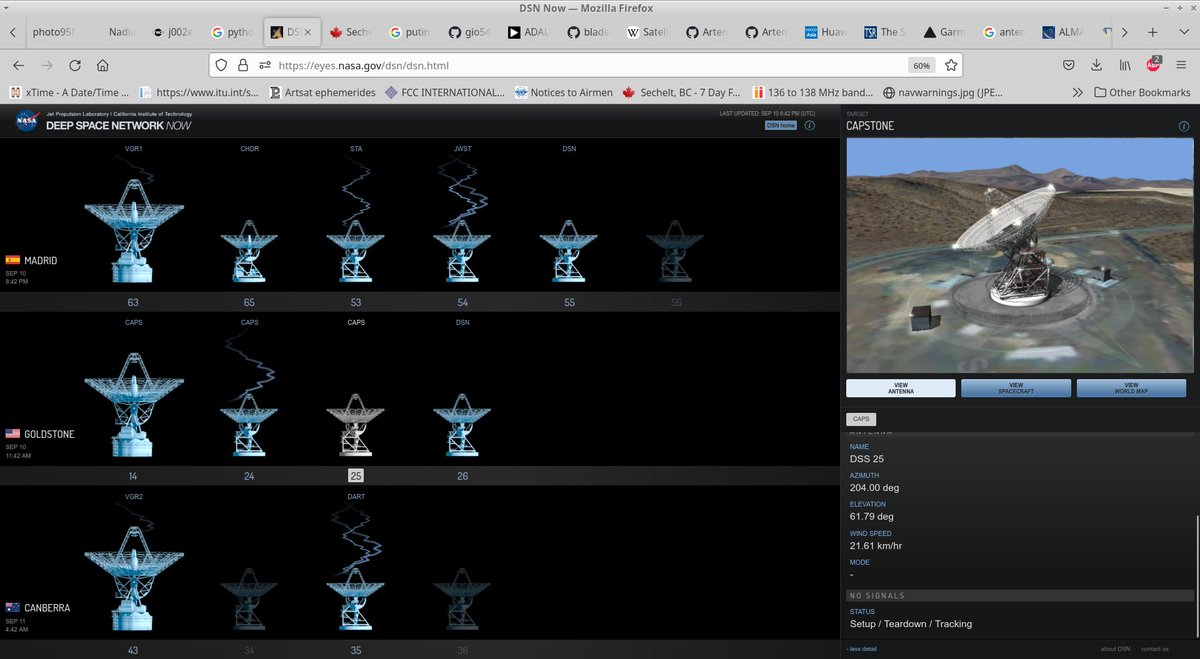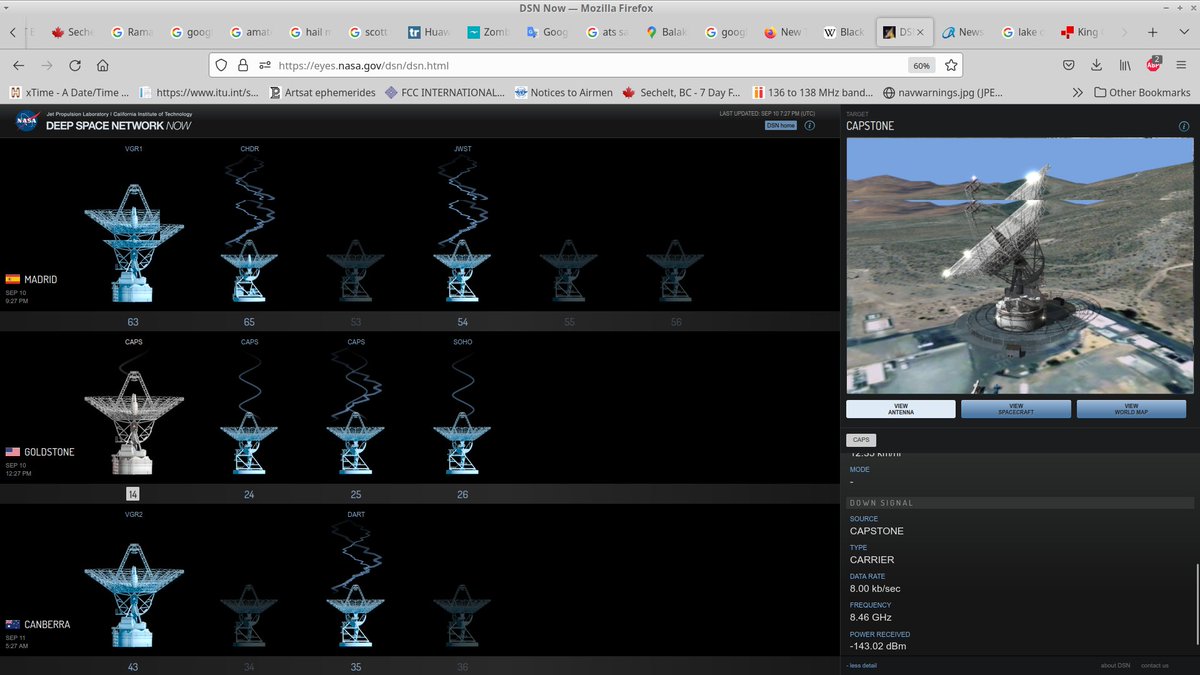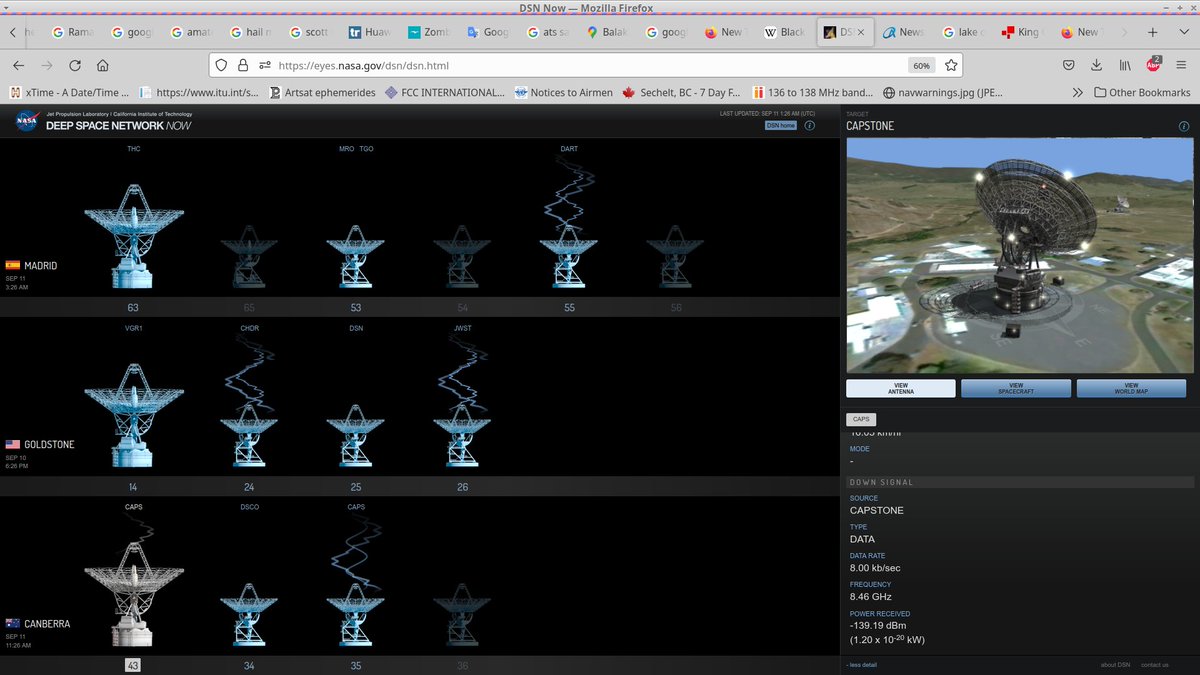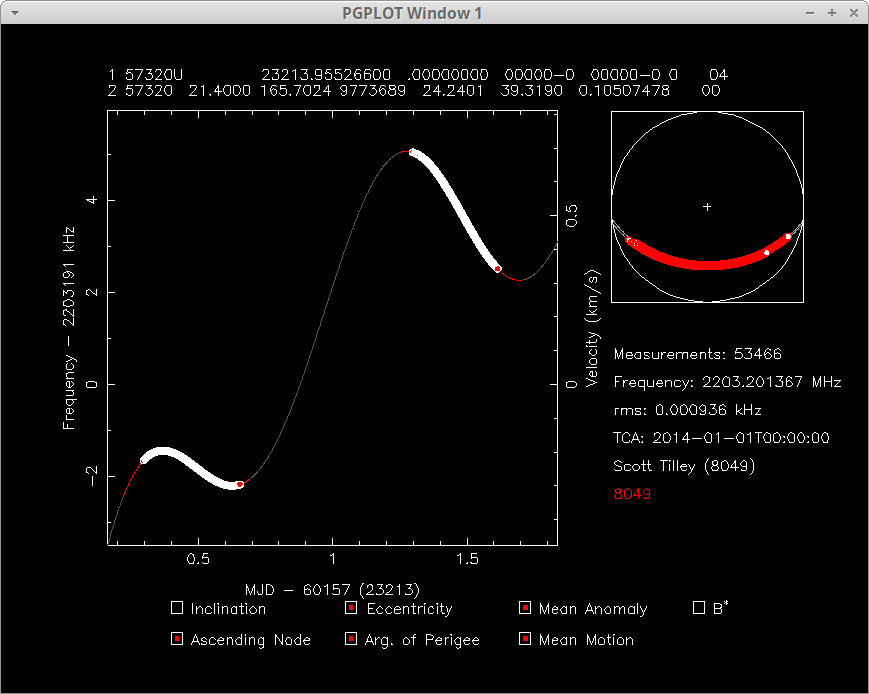⚡️WATCHING:
#CAPSTONE appears to be garnering the DSN's attention over the last day or so. Continuous uplinks with no downlink like the anomaly observed after the spacecraft was released post TLI.
She was scheduled for TCM-3 in early September based on statements after TCM-2.

#CAPSTONE appears to be garnering the DSN's attention over the last day or so. Continuous uplinks with no downlink like the anomaly observed after the spacecraft was released post TLI.
She was scheduled for TCM-3 in early September based on statements after TCM-2.


I'm presently tracking #CAPSTONE on X-band and noting no emissions from it over the last few hours.
DSN NOW just updated and most of Goldstone's DSS antennas are now tasked with #CAPSTONE. Even DSS 14. 

DSS 14 (RX) and 24 (TX) are tracking #CAPSTONE presently. DSS 25 appears to be in the bird bath resting position and not tracking the spacecraft but is labelled as tasked to Capstone.
DSS 25 is now tracking #CAPSTONE too, three of 4 assets from Goldstone. DSS 26 appears to be engaged in radio astronomy or system calibration at the moment as it was tracking something in the northern sky not look straight up... 

DSS 25 takes over transmission to #CAPSTONE, DSS 14 and 24 apparently are tracking and likely listening. Still no signals here with my small X-band station.
~1925UTC noticed that DSS 14, 24 and 25 are indicating weak carrier signal detection ~-136dBm (DSS14) ~-142dBm (24/25). I'm not seeing anything with my system at the present time. At ~1930UTC the DSN stopped reporting carrier. 

Okay this is getting interesting. #CAPSTONE DSN 24 and 25 are reporting carriers again ~1945UTC and then a few minutes later they vanish. Starting to suspect the spacecraft may be rotating slowly. 

The next carrier downlink event started at 2147 and ended at 2150UTC based on the last update clock on the DSN NOW website. So the event if real (I.e. spacecraft signal) doesn't appear to be periodic. The signal levels are low ~-150dBm. 

#CAPSTONE is heading for LOS at Goldstone. More frequent periods of downlink seen with low data (~8kb/s) rates and signal levels (<-140dBm). We'll see how Canberra gets involved shortly. 

DSS 25 has ended transmission to #CAPSTONE as LOS approaches. DSS 24 continues to track presumably listening still. I need to check on ephemeris for Canberra. Looks like DSS 43 and 36 are available. 

Looks like @nascom1 is firing up the big brute DSS 43 for #CAPSTONE. Good ephemeris for the hand over as the spacecraft is about 45 degree elevation and a bit east of north. Recall Capstone is 1.46 million km away and a cubesat so it's power and antenna are limited. 

DSS 24 has ended tracking #CAPSTONE and parked. Even thou Goldstone may still have a view of the spacecraft the low elevation would cause them to end transmission for RF safety reasons and eventually they would run into mechanical limitations for their lowest elevation possible. 

DSS 43 is now tracking #CAPSTONE passively. You can confirm this by obtaining ephemeris from JPL Horizons. 



DSS 35 has come online and aimed at #CAPSTONE. Active recovery efforts from Canberra appear to be about to begin. 

Lets discuss #CAPSTONE's current status, SAFE MODE.
S/C will be attempting to regain orientation to the Sun and switch over to the low gain antenna system. This would explain the low signal levels and use of the large 70m DSN antennas today. MORE
S/C will be attempting to regain orientation to the Sun and switch over to the low gain antenna system. This would explain the low signal levels and use of the large 70m DSN antennas today. MORE
Here's some graphics of #CAPSTONE's solar panels and antennas. At over 1.46e6 km from Earth the signal on a low gain antenna is going to be very weak. The s/c will be struggling to get itself aimed at the Sun to manage power and regulate it's temperature.
https://twitter.com/coastal8049/status/1543832727161434112
DSS 35 is now transmitting to #CAPSTONE while DSS 43 using it's large aperture an ~6dB advantage over DSS 35 listens. 

Back to SAFE MODE topic, #CAPSTONE will be largely in a struggle all on it's own at the moment using it's own systems to orientate itself and stabilize allowing mission control figure out what went wrong and intervene. Which appears to be happening now, D/L being observed! 

The downlink seems to have been lost again from #CAPSTONE, perhaps suggesting that something is changing like the orientation of the spacecraft. As you can see from the images earlier there are likely blind spots for the LGAs we could be seeing a slow rotation or tumble. 

The fact that DSN is using the smaller 34m DSSs to transmit to #CAPSTONE appears to support @AdvancedSpace's statement that they are in actual contact. I.e. they have enough signal at the s/c to get a response back. The challenge appears to be a weak and unstable downlink.
If #CAPSTONE is spinning/tumbling and can't seem to fully stabilize itself, mission control needs to figure out how to intervene and start a process to correct out the undesired rotation. This could take some time as the tiny attitude control system onboard could be saturated.
Lets take a step back and consider the full picture we have on #CAPSTONE. Assuming the anomolly occurred during North American evening then the spacecraft has been fairly stable for almost two days now.
This implies that they are managing power and thermal stress onboard somehow even if the spacecraft is tumbling. They could be doing that a number of ways. reducing loads and only operating certain critical loads on a periodic basis.
Remember #ASTROBIOCUBESAT? It used the transmit period for it's beacon TX period to regulate temperature. If you cycle your transmitter on/off you also save power. This could be what #CAPSTONE is doing now hence the aperiodic data on DSN NOW...
https://twitter.com/coastal8049/status/1547659199756218371
I think for the time being that #CAPSTONE is in a stable yet perilous state.
Stable in the sense that there is communication and intervention could happen, yet perilous, in that they likely have limited time before power margins are diminished to figure out how to intervene.
Stable in the sense that there is communication and intervention could happen, yet perilous, in that they likely have limited time before power margins are diminished to figure out how to intervene.
@threadreaderapp unroll
• • •
Missing some Tweet in this thread? You can try to
force a refresh



















